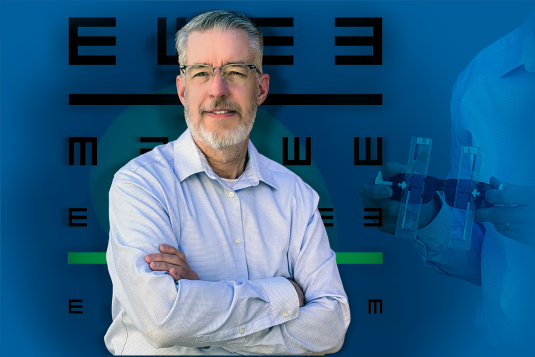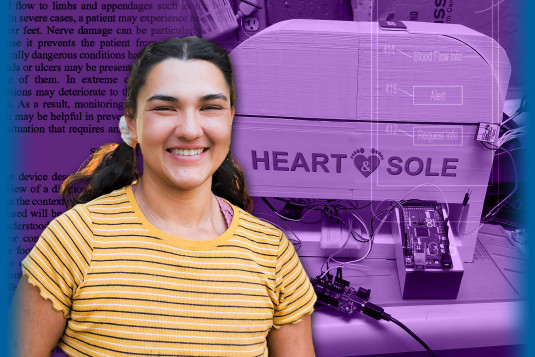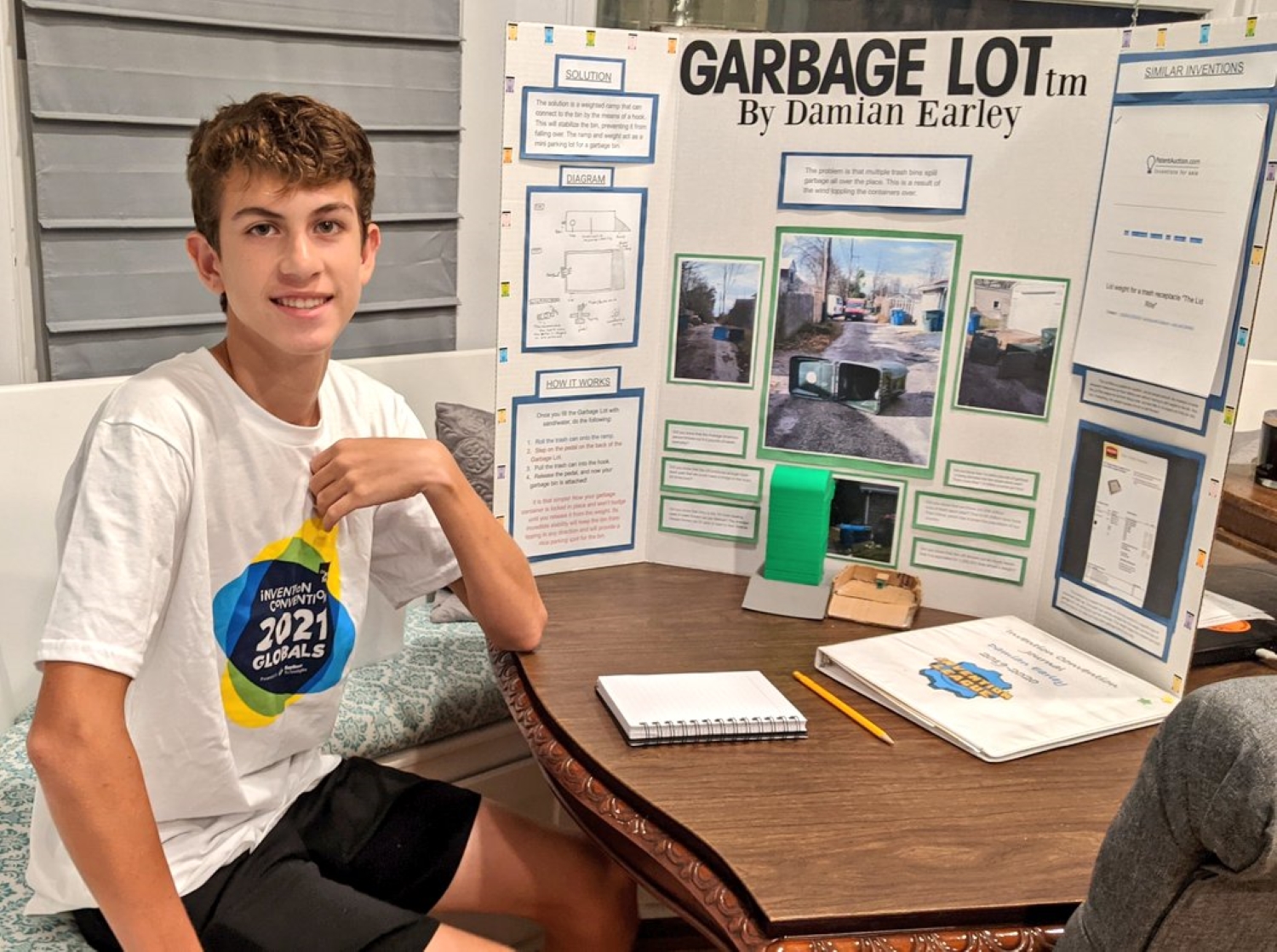
From inspired to inspiring
Inspired by an invention education assembly at school in second grade, Damian Earley spent the next several years creating various contraptions and competing in invention competitions on the local, state, and national level. His success at the competition inspired his siblings to begin their own innovation journeys and led to a patent that may help reduce litter spillage from residential garbage cans. He hopes to inspire others to create a better world through his invention and his work as an engineer.
12 min read
Each month, our Journeys of Innovation series tells the stories of inventors or entrepreneurs who have made a positive difference in the world. This month, Whitney Pandil-Eaton's story focuses on young inventor Damian Earley, who received a patent for an environmentally friendly technology to reduce litter spillage in residential neighborhoods.
Do you know an innovator or entrepreneur with an interesting story?

Litter spillage from overturned residential garbage cans pictured here in the Clintonville neighborhood in Columbus, Ohio inspired young inventor Damian Earley to design and patent a weighted platform with a locking mechanism to keep trash cans upright in windy or other adverse weather conditions.
(Courtesy of the Earley family)
It was a blustery fall day in Columbus, Ohio in 2018 when then-12-year-old Damian Earley was taking his dog, Jagger, a boxer, out for his daily constitutional in their Clintonville neighborhood when he observed several trash cans had overturned in the wind, spilling the landfill-destined, single-use plastic containers, fast food wrappers, and other garbage into the narrow urban streets and alleyways of his neighborhood.
The sight of plastic containers rolling along side streets, grocery bags mangled in residential chain-link fences, and everyday refuse strewn about the streets left an impression on the seventh-grader.
“I like the beauty of nature and it’s pretty sad to me that some aspects are disappearing,” he said, highlighting several environmental disasters in recent memory. “The environment has always been very important to me. I really want to make the world a cleaner place.”
An inventor since third grade, Damian learned how to tackle real-world problems both big and small through his participation in the Ohio Invention League. Similar to the National Inventors Hall of Fame’s Camp Invention, the non-profit organization offers free STEM education to K-12 students. Robin Hilsmeier, executive director of the league, said approximately 6,000 students participate annually and nearly 500 go on to compete in the League’s district, regional, and state-level invention competitions. Winners can earn between $150 and $2,500 CollegeAdvantage 529 Savings awards.
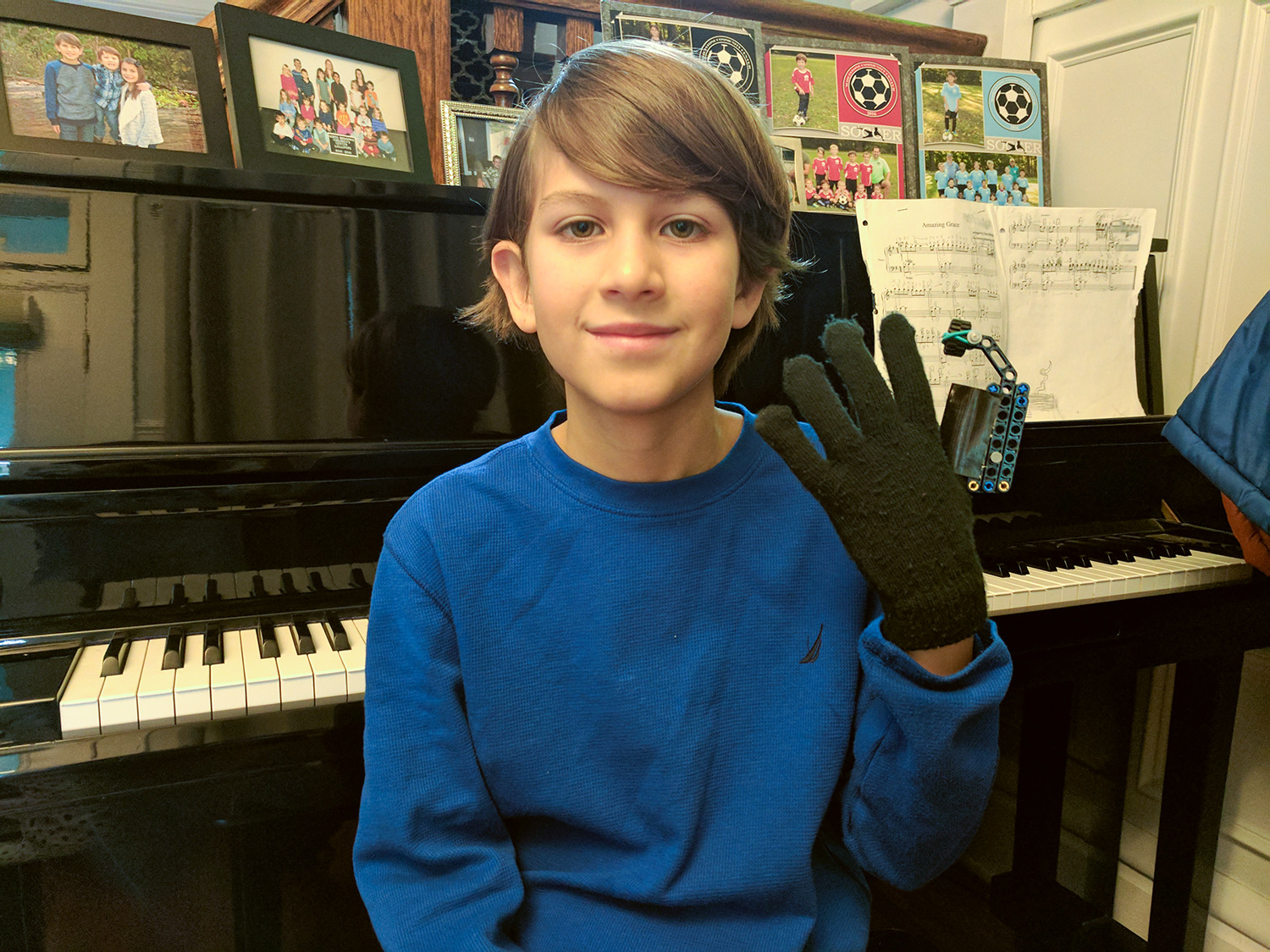
Damian Earley, then in fifth grade, showing off his invention called the “Octglove,” which extends the finger reach for pianists with small hands. He competed at the state level with this invention. In addition to playing the piano, Damian is also a first chair cellist.
(Courtesy of the Earley family)
Damian was introduced to the invention league through a school assembly in second grade.
“They did activities, games, and had wacky hairdos,” he said. “It made [inventing] seem really interesting and fun.”
That excitement led him to participate in the program at the local, state, and national level, winning awards at each for his diverse set of inventions: the “Drone D Medideliverer,” a drone delivery system for prescription medications; a multi-task robot butler designed to entertain, feed, and water pets called the “Dog BonE”; and the “Octglove,” a glove that extends the finger-reach span for pianists.
But it was his latest invention, “The Garbage Lot,” that would cement Damian’s legacy as an inventor.
Recalling the sight of the garbage-strewn streets a year prior, then eighth-grader Damian began researching and designing a weighted platform for residential garbage cans that had a locking mechanism to keep the cans in an upright position.
“I liked my idea,” he said. “But I never thought it would go this far.”
Damian submitted “The Garbage Lot” to Ohio’s Invention Convention competition in 2020. After winning the “Industry Innovator Award” in the environment and sustainability category on the state level, Damian’s invention was then submitted to the national competition where he won first-place for ninth grade and was awarded a Patent Application award. The award enables the inventor to receive free patent application services from a law firm that specializes in intellectual property. Victor Kernus, patent attorney with Cantor Colburn LLP, worked on Damian’s application process.
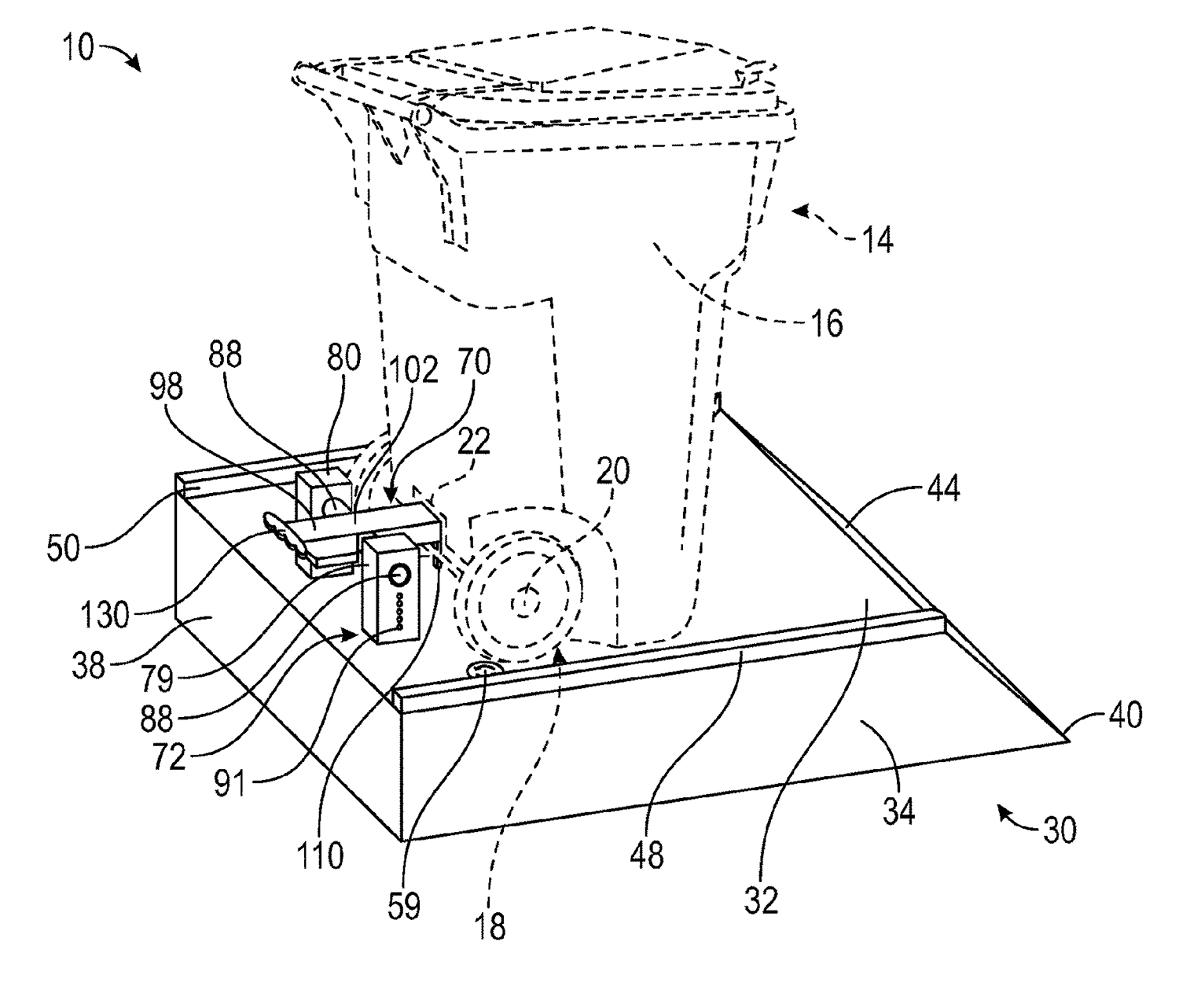
Eleventh-grader Damian Earley recently received U.S. Patent No. 11,565,878 for a garbage bin support member. This weighted platform base uses a hook locking mechanism to engage the axle of the garbage bin to prevent the trash can from tipping over. Damian received pro bono patent application services after placing first-place for his grade level at the Invention Convention U.S. Nationals. He plans to license or sell his patent and use the funds to pay for his college education.
Having written more than 1,000 applications, Kernus said Damian’s patent process—which took approximately one year—was quick. He received his patent in January.
“Trash cans are a very dense art…there are thousands of patents on different trash can options,” Kernus said. “He found a niche and that niche was fulfilled by his invention. It was novel enough to get through the Patent Office fairly quickly.”
Depending on the length of the prosecution, the cost to obtain a patent can run anywhere from $10,000 to $40,000, he said. Due to the high cost, Kernus said pro bono work in the intellectual property field is vital – and the statistics bear that out.
The Patent Pro Bono Program run by the United States Patent and Trademark Office provides free patent preparation, filing, and prosecution assistance to low-income and underrepresented inventor groups through its nationwide network of not-for-profit regional programs. To date, program assistance has resulted in more than 2,000 patent application filings that might otherwise have not been possible because of cost or lack of access to legal expertise.
Additionally, there are several regional organizations that provide pro bono services. For example, Minnesota-based LegalCORPS’s Inventor Assistance Program provides free legal representation to low-income inventors who are attempting to obtain a patent for their invention in North Dakota, South Dakota, Minnesota, Iowa, and Wisconsin.
These pro bono programs help remove some of the obstacles inventors face when trying to patent their inventions.
“Barriers can be moved,” Kernus said. “You can go under, you can go around, you can go over, you can get out some explosives and go through. There’s always a path forward.”
After serving as a competition judge and providing pro bono services for several years, Kernus said the young inventors involved in the invention competition hold a special place in his heart.
“It’s fun. I’d take them all [on as clients] if I could,” Kernus said. “These inventors are so excited to go through the process. Their excitement is infectious.”
Damian’s excitement for innovation was evident from an early age.
His father, Matt, said his son was a very creative child who loved to build, draw, and create.
Damian’s creativity and intrinsic motivation to succeed was also noticed by his teachers.
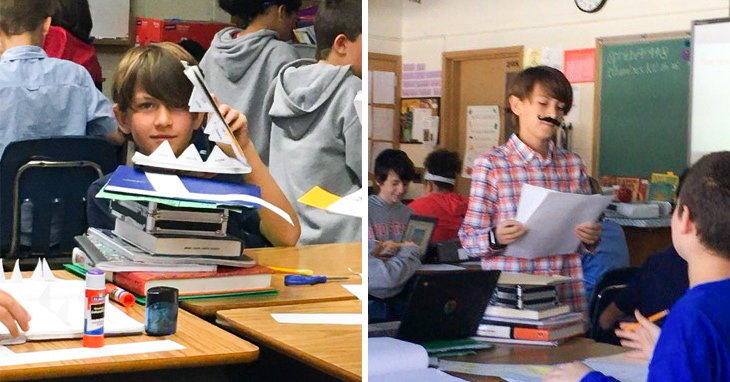
Creative and self-motivated, Damian impressed his teachers with his work ethic and positive attitude. Pictured on the left is young Damian, who transformed a notebook into a "shark" during a school assignment. On the right, Damian is photographed while delivering an oral presentation in sixth grade wearing a fake mustache and costume.
(Courtesy of Sarah Priebe)
Sarah Priebe, who taught him language arts and social studies in sixth grade, recalled an assignment that required the students to research and give an oral presentation on a person and geographic region. She said Damian came dressed up in a costume—fake mustache included—and presented the material in a way that she hadn’t seen from students in the four previous times she had taught the lesson.
“You can tell he put a lot of time and practice into it,” Priebe observed of Damian’s performance. “It’s not something you see often.”
Priebe continued to witness Damian’s intrinsic work ethic when she became the gifted curriculum coordinator at the middle school and worked with him through his eighth-grade year.
Because gifted students don’t seem to need to work as hard to excel at school, Priebe said keeping them motivated can be challenging in her experience.
“Damian was always engaged, always listened, always ready,” Priebe said. “He’s just a great kid.”
Damian’s work ethic and attention to detail brought success in the invention convention competitions. His first year he won third place in the school district Invention Convention competition and went on to compete at the state level with his “Drone D MediDeliverer” device. Each of Damian’s inventions has advanced to at least the state level of the invention competition. After winning at the National Invention Convention, his “Garbage Lot” device went on to compete in the Global Invention Competition.
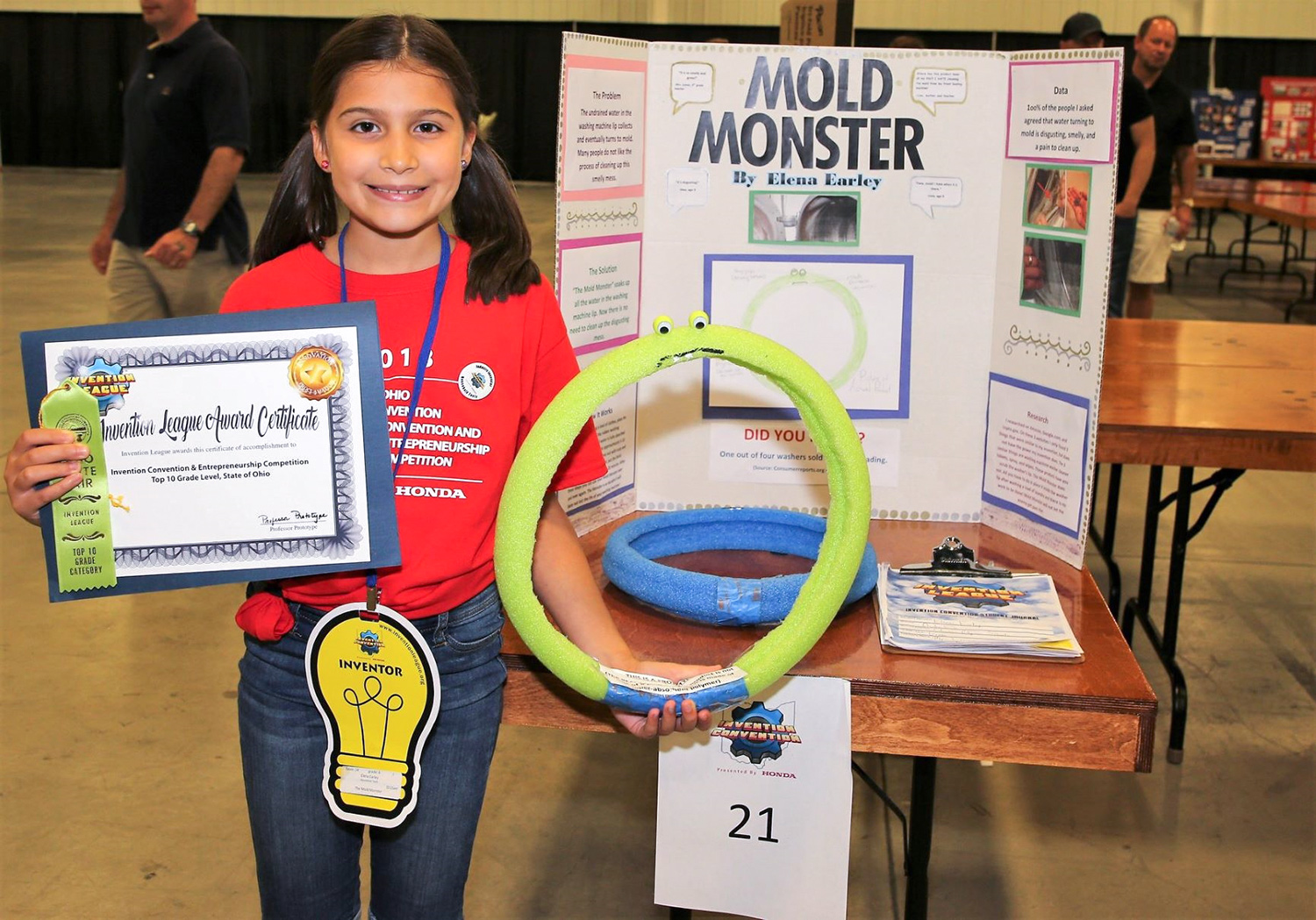
Elena Earley holding her "Mold Monster" invention, an absorbent ring for front-loading washing machines.
(Courtesy of the Ohio Invention League)
That success inspired his younger siblings Elena, 14, and Zavier, 11, to create their own inventions and participate in the invention league competition.
“I saw Damian had a great time [doing invention convention] so I wanted to try it, too,” said Elena.
In fourth grade Elena invented the “Mold Monster,” an absorbent ring made of polymer material that can be placed in the door seal of front-loading washing machines. She came up with the idea after hearing her mom complain about odors emitting from the washing machine. Another invention, the “MicMask,” has a built-in microphone and amplifier to increase the voice projection of the person while wearing a protective mask. Created in 2021, Elena’s mask invention won first place for her grade level in the state competition. Both of her inventions were invited to compete in the National Invention Convention.
Following in his older siblings’ footsteps, Zavier has participated in invention competitions four times.
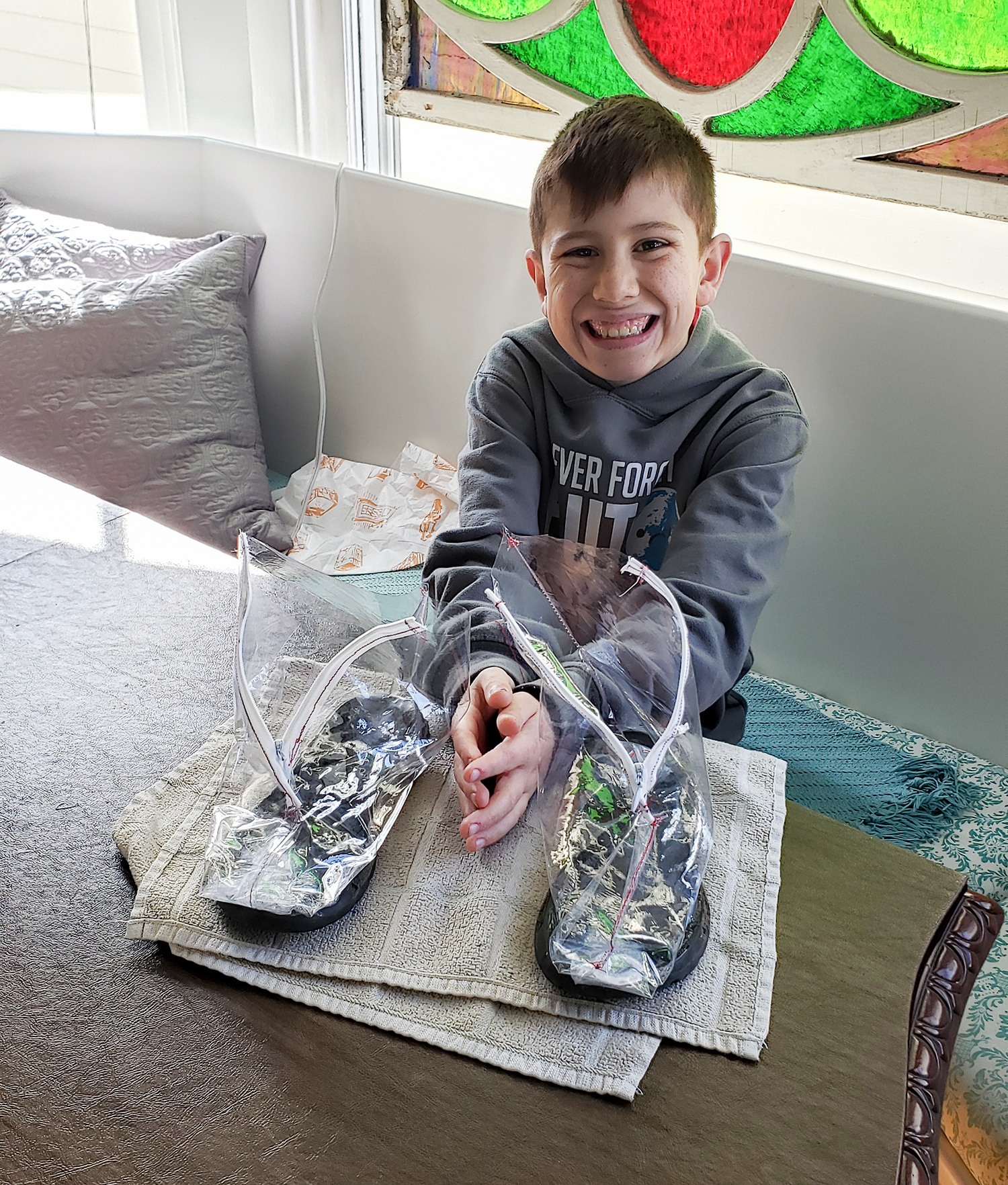
Zavier Earley is pictured with his "Shoe Preserverz" invention. Designed to be zipped up over a shoe, the transparent sheath protects shoes from getting dirty in wet and muddy conditions.
(Courtesy of the Earley family)
He began his career in innovation in first grade with his invention “Brick Drone,” a drone with arms that can transport heavy objects for people with reduced strength or mobility. Other inventions include a shoe shield—created to protect sports-playing surfaces from damage from cleats—and “Eyebuds,” blue screen glasses with attached headphones and microphone to increase comfort during online learning. Zavier won third place in the state competition for his grade level for “Eyebuds” and went on to compete in the National Invention Convention.
While the Earley kids have enjoyed the accolades, the skills they developed while participating in invention convention are the real takeaways.
“All three of the kids have gained confidence in their communication skills and it has opened up conversations for our family about problem-solving,” said their mother, Lisa. “Participating has really opened a lot of doors [for them]. Those [invention] teachers inspired that first glimpse of invention motivation that has stayed with them for all these years.”
Their father, Matt, added that watching the invention process take place—identifying a problem, researching, journaling, and creating and refining prototypes—has changed how he tackles issues in his vinyl records business.
The ability to identify real-world problems and provide solutions is what the Ohio Invention League is all about, Executive Director Robin Hilsmeier said.
“We want our students to be lifelong problem-solvers,” she said, adding that a recent world economic report found that a top trait CEOs will be looking for in employees is the ability to solve complex problems. “We tell our students that they will likely work in jobs that have not yet been created. [As those industries develop] employers are going to need thinkers and problem solvers.”
With a background in mechanical engineering, Kernus said these youth STEM education programs are vital to the future of the country.
“STEM is in every factor of life these days. You can’t build buildings, you can’t build computers, you can’t even print books now without engineering,” he said. “These programs build excitement for these kids and show them what STEM can do for them.”

The Earley children were invited to participate in the Inventors Day celebration at the Ohio State House. Pictured from left: Damian Earley, Elena Earley, Abby Fisher, AKA “Professor Prototype,” and Zavier Earley. Fisher recently retired from the Ohio Invention League after 25 years in various educational and mentorship roles with the non-profit STEM education organization.
(Courtesy of the Earley family)
The Ohio Invention League, an affiliate of Invention Convention Worldwide, takes STEM education a step further by incorporating invention and entrepreneurship into their “STEMIE” programming. Including those aspects into their program helps students complete the entire lifecycle of an invention, Hilsmeier said.
As part of the competition, students must “pitch” their invention to judges. Crafting, writing, and practicing their invention pitch helps hone their communication skills and practice entrepreneurship, she noted.
Due to the open nature of inventing and the transdisciplinary process, Hilsmeier said students of all ability levels have participated and found success in the program and competitions.
“It doesn’t matter what learning level you are at. A student that has learning challenges can be every bit as successful as another student,” she said. “We have kids on the spectrum who end up at Nationals that do an amazing job.”
Hilsmeier said the main traits of great problem solvers—creativity, empathy, critical thinking and innovation—are all incorporated into the invention education program.
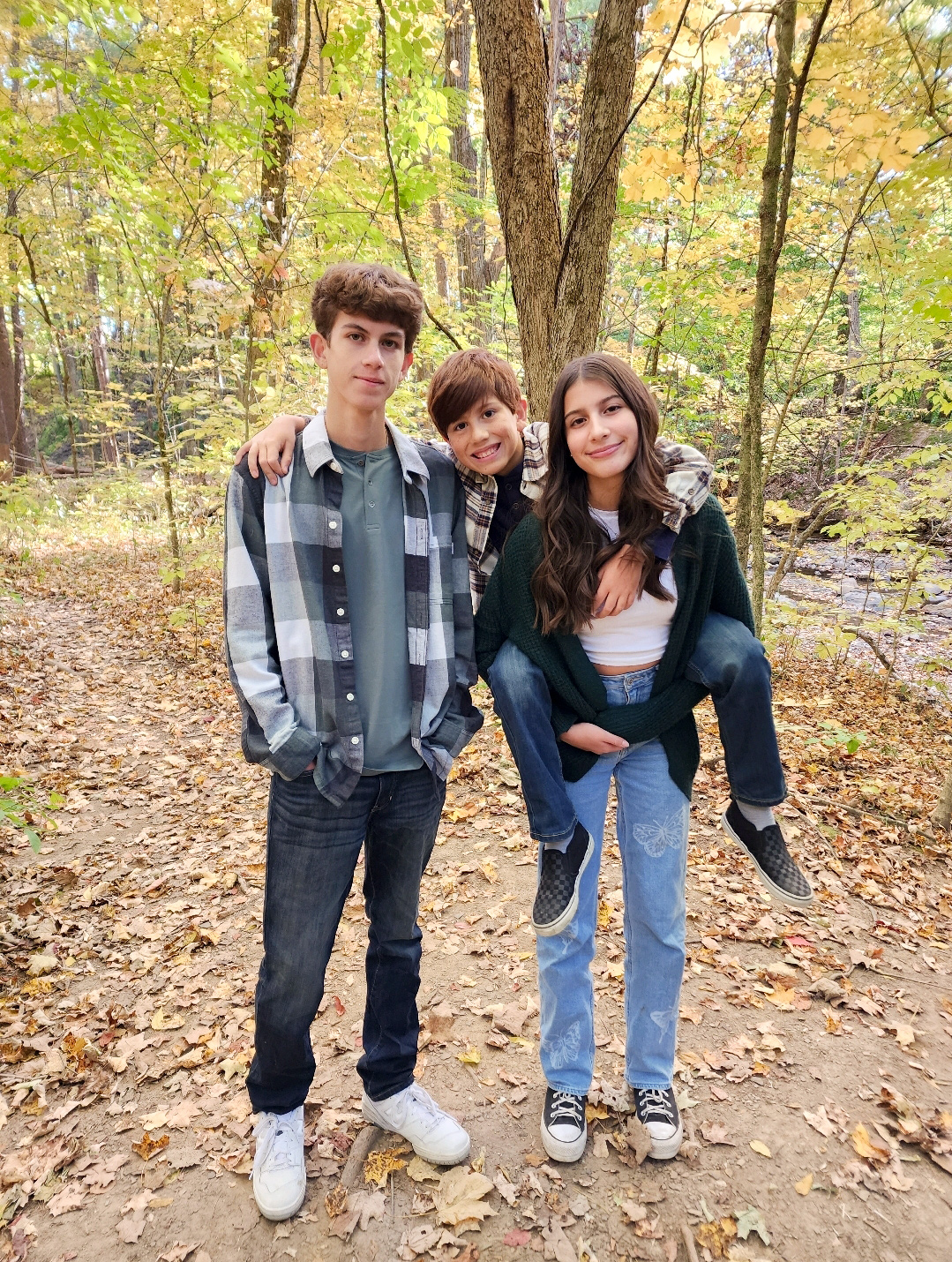
Damian, Elena, and Zavier Earley pictured at the Columbus Park of Roses in Columbus, Ohio.
(Courtesy of the Earley family)
“You use those skills in a wide variety of circumstances in life,” she said. “Once you go through the [invention] process, you start to recognize problems all over the place. It becomes a way of thinking.”
The Earley children are using their problem-solving skills to take on the challenges that come in the next phase of life.
With SAT testing, senior year of high school, and college on the horizon, 17-year-old Damian said he is retiring from invention competition but will be using the skills he learned to pursue a degree in civil, environmental, or structural engineering. He is hoping to license or sell his garbage bin platform patent to a company and use the proceeds to pay for his college education.
Now a freshman at Whetstone High School, 14-year-old Elena said she wants to use the communication skills she honed during her invention convention experiences to pursue a law degree. She recently received the “outstanding attorney” award for a mock trial program she participated in through her school.
Zavier, now 11 and a fifth grader at Clinton Elementary School, said he plans to continue participating in the invention convention competition and see where his innovation takes him.
“Even if you [don’t] win, you feel good about yourself and proud of what you made,” he said.
Credits
Produced by the USPTO’s Office of the Chief Communications Officer. For feedback or questions, please contact inventorstories@uspto.gov.
Story by Whitney Pandil-Eaton. Additional contributions from Jon Abboud and Eric Atkisson. Special thanks to the Earley family, Sarah Priebe, Robin Hilsmeier, Victor Kernus, and Amy Calhoun.
References
Damian and Matt Earley, interview by Whitney Pandil-Eaton, February 17, 2023.
Sarah Priebe, interview by Whitney Pandil-Eaton, February 22, 2023.
Victor Kernus, interview by Whitney Pandil-Eaton, February 22, 2023.
Robin Hilsmeier, interview by Whitney Pandil-Eaton, February 28, 2023.
Earley family, interview by Whitney Pandil-Eaton, March 5, 2023.
Earley family, interview by Whitney Pandil-Eaton, March 18, 2023.
"LegalCORPS Inventor Assistance Program." LegalCORPS.org. March 20, 2023. https://legalcorps.org/inventors/inventors-2


